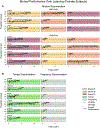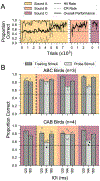Sex differences in vocal learning ability in songbirds are linked with differences in flexible rhythm pattern perception
- PMID: 37842009
- PMCID: PMC10569135
- DOI: 10.1016/j.anbehav.2023.05.001
Sex differences in vocal learning ability in songbirds are linked with differences in flexible rhythm pattern perception
Abstract
Humans readily recognize familiar rhythmic patterns, such as isochrony (equal timing between events) across a wide range of rates. This reflects a facility with perceiving the relative timing of events, not just absolute interval durations. Several lines of evidence suggest this ability is supported by precise temporal predictions arising from forebrain auditory-motor interactions. We have shown previously that male zebra finches, Taeniopygia guttata, which possess specialized auditory-motor networks and communicate with rhythmically patterned sequences, share our ability to flexibly recognize isochrony across rates. To test the hypothesis that flexible rhythm pattern perception is linked to vocal learning, we ask whether female zebra finches, which do not learn to sing, can also recognize global temporal patterns. We find that females can flexibly recognize isochrony across a wide range of rates but perform slightly worse than males on average. These findings are consistent with recent work showing that while females have reduced forebrain song regions, the overall network connectivity of vocal premotor regions is similar to males and may support predictions of upcoming events. Comparative studies of male and female songbirds thus offer an opportunity to study how individual differences in auditory-motor connectivity influence perception of relative timing, a hallmark of human music perception.
Keywords: auditory perception; auditory–motor interaction; comparative cognition; isochrony; sensorimotor circuit; zebra finch.
Conflict of interest statement
Declaration of Interest None.
Figures










References
Grants and funding
LinkOut - more resources
Full Text Sources
